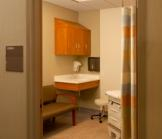The US style of walk-in clinic that is now starting to gain wide acceptance has at its heart a room they call the Exam Room.
In Australia we do not seem to have yet settled on an official design, but some pharmacies have dedicated rooms they call treatment rooms, counselling rooms or consulting rooms, or no identification at all.
While most US clinics are primary health care clinics staffed by nurses it seems reasonable to use the word exam clinic, given that type of setting.
I would prefer to see clinics in Australia develop as pharmacist-led but not ruling out collaboration with nurses or other health care practitioners.
Some of the busier US style pharmacy clinics now attract doctors.
Australian clinics should create designs for their rooms that suit the Australian market and the type of practitioners they will house because a lot of rooms will evolve from beauty treatment rooms and may continue to embrace specialist cosmetic activities as part of the normal health procedures.
The comments that follow relate strictly to US developments.
Material can be adapted but it does not necessarily relate to what will suit an Australian pharmacy.
While most exam rooms feature basic components that have been standard for many years, their size, interior layout, aesthetics, and relationship to adjacent spaces are evolving.
 This is primarily because the activities occurring within exam rooms have changed in the past decade—and will continue to change.
This is primarily because the activities occurring within exam rooms have changed in the past decade—and will continue to change.
Exam rooms vary between clinics depending on location, care philosophy, patient population, specialization, and other factors.
For example, clinics that focus on fast, convenient care often have compact, uniform exam rooms that have just enough room for an exam table, supply storage, basic seating, and possibly a small staff work area.
Conversely, clinics that conduct multiple tasks within an exam room—from patient check-in to obtaining lab specimens, conducting consultations and scheduling follow-ups—strive to create flexible, comfortable exam rooms because they are completing more tasks and patients will be in the room longer.
In other instances, developments in care delivery are transforming the exam room. For instance, a Care Suite configuration combines consultations and exams into a single suite with furnishings arranged so that physician and patient sit side-by-side and discuss test or exam results over a table.
In the Exam + Rooms configuration, the exam room is slightly larger than average with the additional space used for educational purposes, especially for seriously or chronically ill patients.
Still, other exams rooms may be more flexibly designed—with nofixed elements besides plumbing, for instance—to allow emerging collaborative care or group exam models.
Whatever the configuration, the exam room is the focus of any clinic because all roads lead to the exam room. The most successful exam rooms streamline work processes, help alleviate “white coat anxiety” for patients, and break down barriers by placing the caregiver side-by-side with the patients as patients take greater ownership of their healthcare.
Ensuring that design supports the program is important for the overall success of a clinic.
